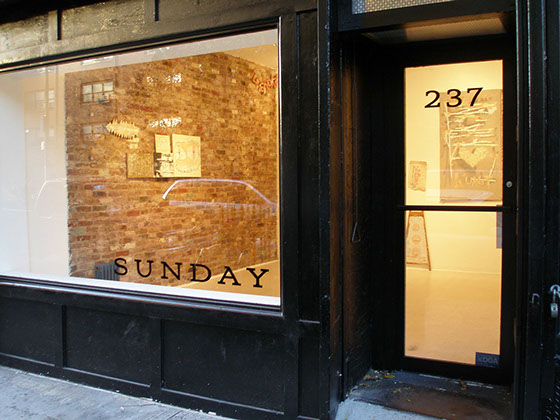
Storefront of SUNDAY L.E.S., New York
Courtesy of Peter Gallo and Horton Gallery
Photo: Mark-Woods.com
Scott Robinson with C. Sean Horton
Scott Robinson: The exciting news is your merger with Zieher Smith. What can you tell us about how that came about?
C. Sean Horton: Like a lot of decisions made in the art world, the conversation was born from our mutual respect, appreciation, friendship, and of course…real estate. Scott and Andrea have always been trusted colleagues whom I would ask advice or share information, so the dialogue evolved naturally. I was looking for a more prominent space for the gallery and they were looking to expand their staff and program. After about a week of lengthy conversations, it seemed like a good next phase for us all.
SR: On the new Zieher Smith & Horton website, Andrea Zieher says in reference to you, “our interest were remarkably similar.” What interests do you share? Can you expand on that? And as you were discussing a merger, what was surprising about your common goals?
CSH: I have noticed that we both appreciate works that exhibit a certain kind of materiality; often that is a focus on tactility and color. Sometimes our exhibitions explore the line between art and ephemera. We both seem to root for the underdog by showing work that falls outside of current trends. I think that we appreciate stories, personal narratives, and understand artwork in terms of sincerity. In that regard, we have both done shows by artists well into their 50s, 60s and beyond –which are sometimes their solo debuts.
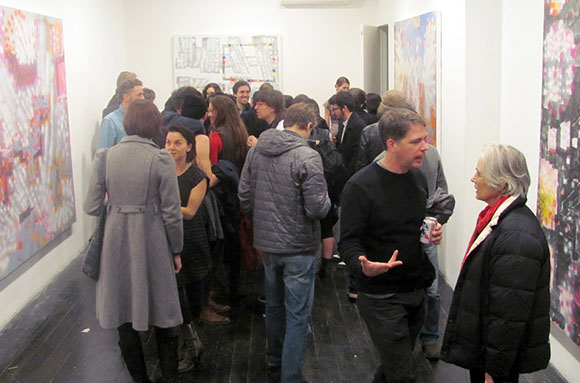
Opening of Keltie Ferris, KF + CM 4 EVER at Horton Gallery
Courtesy of C. Sean Horton
SR: What are some of the challenges you anticipate?
CSH: While we do have a lot of similar interests, we all come at art from highly idiosyncratic ways. For example, my understanding of art is informed in large part by regionalism, sexuality, and religion. Learning how to balance those ideas in our new overall gallery program will require a lot of consideration.
SR: How did the artists you represent respond to the news?
CSH: Everyone has been very excited by the new prospects that this offers for the future. We also have plans to add several new artists to the program.
SR: A return to Chelsea seems like a contrarian move, but I get the sense that you’ve often done things differently than everyone else. You’ve started multiple projects including BR & S, Horton, and Sunday. Have you made a point of breaking molds and what has given you the confidence that your moves will be successful?
CSH: In 2006, I was able to open a gallery in the Lower East Side with less than $10,000 in the bank. I'm not sure that you could ever have done that in Chelsea, but the Lower East Side has always had a great entrepreneurial spirit. Maybe that allows anyone with the desire to open a gallery. But once you have been operating a gallery for close to ten years, you want your shows to be seen by the largest audience possible. Chelsea remains the world's premiere art district and I'm confident that more members of the gallery's audience will see our shows in Chelsea.
In most cases –especially in the case of Big, Red & Shiny– I decided that I could only say "Someone needs to do this." so many times before it became a self-indictment. If I see a need for something and no one else beats me to it, then I tend to try and do it myself.
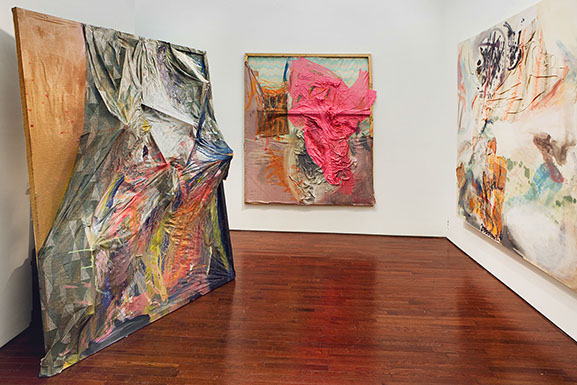
Installation View: Lauren Luloff, From The Sheets,
Horton Gallery (SUNDAY L.E.S.), New York
Courtesy of Lauren Luloff and Horton Gallery
Photo: Mark-Woods.com
SR: What is most satisfying about what you do?
CSH: I enjoy having a variety of conversations and experiences on a daily basis. It's an interesting challenge to understand how art functions for artists, collectors, museums, press, and spectators. I've traveled to a variety of places that I probably wouldn't have been able to experience otherwise.
SR: What guides your working philosophy? What means that you’ve done well?
CSH: Quit if you can? I am owed more money than I owe?
SR: You’ve said that you show what you like; it’s idiosyncratic. How has your taste changed over the years?
CSH: It's not that my taste has changed much over the years, it's that my understanding of my role as a gallery owner and art dealer has changed. The same things that excited me as an artist still excite me as a dealer, but that's something different than choosing to exhibit 'this' or 'that' work of art.
SR: In my interview with Christian Maychack, he said his dealer Gregory Lind was an important influence. I know you have a knack for discovering new talent. Do you find that an artist’s work will generally improve once you decide to represent them?
CSH: I think a lot of artists have more success in the studio when they are working towards exhibitions or have the sense that someone else is promoting them. I've titled works for artists and made suggestions about new bodies of work, even new mediums in some cases –all with varying degrees of success.
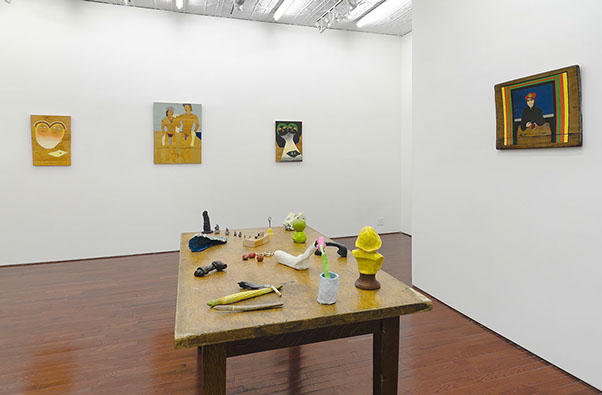
Installation View: Leidy Churchman, Good Afternoon!
Horton Gallery (SUNDAY L.E.S.), New York
Courtesy of the Leidy Churchman and Horton Gallery
Photo: Mark-Woods.com
SR: Are there collectors who have been loyal to you since the beginning or for a long time? What have they meant to you?
CSH: Most collectors tend to be very active for a limited amount of time. Then they run out of space, or money, or are tired of buying things for storage. But I've had ten-year dialogues with some collectors who don't always purchase. Those tend to be the most informative and beneficial relationships. Inevitably, I spend more time with some collectors than others and while they're not friendships in the traditional sense, there is a mutual appreciation for each other.
SR: What quality in an artist interests you the most?
CSH: I interviewed Dan Elias once on Big, Red, And Shiny. His response to a similar question has always resonated with me:
"My theory for selecting artists is very simple. I want it all. I want an artist to produce work, which has been thoroughly considered, from top to bottom. I want a marvelous, memorable visual impression, and a rich, satisfying set of ideas to back it up (sounds like a beer commercial, doesn't it?). I want to be able to think about an individual work for a long time, and then when I see another piece by the same person, I want to be surprised and pleased by the new ideas and connections they have shown to the earlier work that I couldn't have made myself. I want them to work hard, and think about everything –all the time. Take responsibility for every aspect of the experience they are giving the viewer, and not require the viewer to do the work. The viewer has other tasks to attend to."
SR: Who is an artist whose work/career you follow, someone that interests you that you don’t represent and what is it about their work that you respect?
CSH: There are too many to name here, but I've always been intrigued by Joseph Marioni and his commitment to monochromatic painting (before it was cool). Lately I've been taken with Luigi Ghiri's photographs of Morandi's studio. My wife is a graphic designer and art director, so we have been considering Matthew Brannon and Andew Kuo for our personal collection.
SR: What’s the most important part of your relationships with artists you represent?
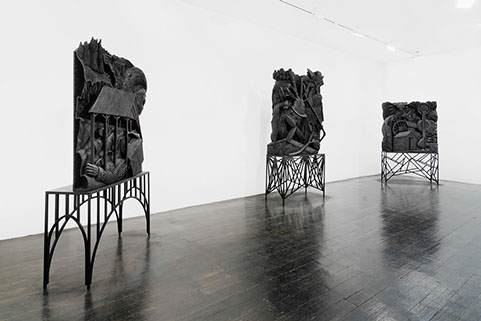
Installation View: Aaron Spangler,
Government Whore, Horton Gallery, Chelsea
Courtesy of Aaron Spangler and Horton Gallery
Photo: Mark-Woods.com
CSH: Even though it often becomes a close relationship, it is ultimately a professional relationship and not a friendship. The exception to this is perhaps when you're already friends with someone with whom you later begin to work.
SR: Kirk Hayes is one of my favorites on your roster. What’s the story of how he became involved with your gallery?
CSH: Kirk's work was included in several museum shows in Texas while I was an art student. Most memorable in a great show called Natural Deceits at the Fort Worth Modern. When I began working in galleries in New York, he came to mind as a completely unique painter who had been overlooked and deserved notoriety. He's a bit reclusive but I sought him out for months by phone and email. A mutual friend eventually knocked on his door for him and told him to call me. I flew down to Texas to meet with him over a chicken-fried steak and we planned his first New York show.
SR: Can you talk about a successful example of a time when you supported an artist you believed in despite their lack of sales initially?
CSH: I don't think I've ever worked with any artists who immediately had strong sales. It is always a building process. In my experience, it's never the art that sells itself or the dealer that can sell everything easily. It's always the combination of the two that occurs in a successful artist and gallery relationship that helps to create a strong demand and market.
SR: How do you feel about art fairs?
CSH: I enjoy the extended audience that they bring for the gallery and its artists. They can be physically, emotionally, and financially draining but that's usually offset by the experience of the cities that you get to visit and colleagues with whom you get to know at the bar after the fair each night.
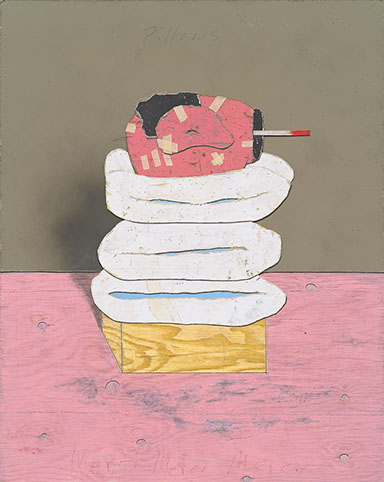
Courtesy of Kirk Hayes and Horton Gallery
Photo: Mark-Woods.com
Kirk Hayes
Pillows, 2011
Oil on panel (trompe-l'œil)
40x32"
SR: What kind of influence are they having on your business?
CSH: Fairs together with the internet have probably led to a decline in attendance at exhibitions. But the extended global audience offsets that decline. Perhaps this trend away from brick-and-mortar in other industries is simply now reflected in this industry.
SR: What have you read that’s been influential either recently or in the past?
CSH: Art and the Bible by Francis Schaeffer was very influential book for me when I was studying Christian theology before art school in Texas. The music of Lift to Experience, Josh T. Pearson, The Hidden Cameras, Slim Cessna Auto's Club, Pedro the Lion, David Bazan have all been more influential to me than literature. These days, I listen to a lot of podcasts of Fresh Air with Terry Gross, which always stick with me.
SR: I’m really going to put you on the spot for the last question: Who makes the best BBQ in Texas?
CSH: One of my first jobs was at Hickory Bar-B-Que in Bonham, Texas so I have a soft spot for that place. I rarely eat barbecue these days, I'm more of a fried chicken guy, but my Dad loves Cooper's in Llano…I believe…his favorite spot changes a lot.
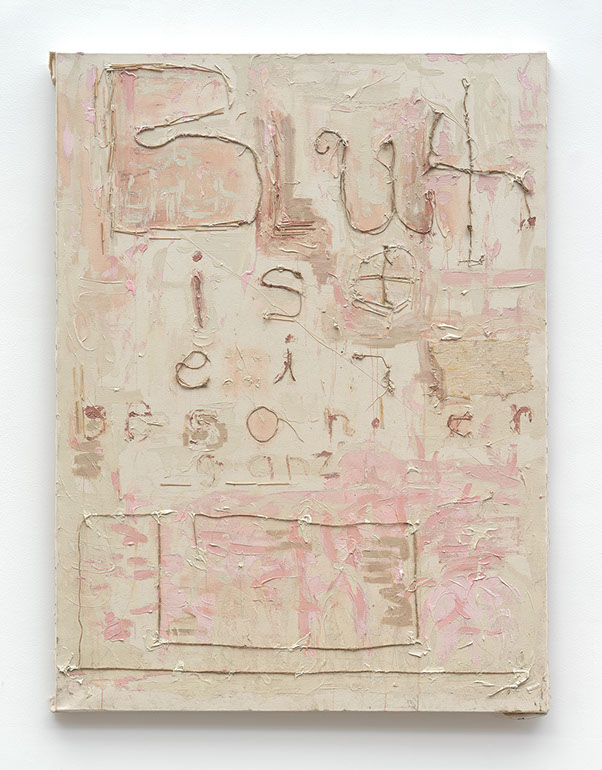
Courtesy of Peter Gallo and Horton Gallery
Photo: Mark-Woods.com
Peter Gallo
Blut ist bläh bläh, 2012
Oil, twine, house paint & toothpicks on canvas
48" x 46"
C. Sean Horton is a well known art dealer and gallerist in New York City. He is also the co-founder of the online arts journal Big, Red & Shiny.
From the website:
Horton Gallery was founded by C. Sean Horton in 2010 and occupied the parlor floor of a federal-style house on West 22nd Street in Chelsea for two years. During these years the gallery also operated a project space in the Kreuzberg neighborhood of Berlin, Germany.
The gallery, its artists, and highly idiosyncratic program have since received critical acclaim in Artforum, Flash Art, Frieze, Modern Painters, Art in America, Time Out New York, The Brooklyn Rail, The New York Sun, The Village Voice, and The New York Times, among others.
From the website:
Scott Zieher, Andrea Smith Zieher, and C. Sean Horton are pleased to announce their new joint venture, Zieher Smith & Horton. This collaboration will present the critically acclaimed intergenerational mix of artists already associated with ZieherSmith and Horton Gallery
Disclaimer: All views and opinions expressed are those of the authors and do not necessarily reflect the views of the editors, owner, advertisers, other writers or anyone else associated with PAINTING IS DEAD.

